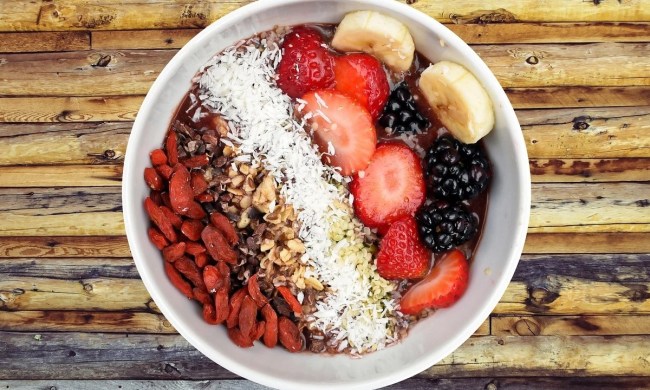
Simply put, Japanese matcha is one of the healthiest beverages in the world. Rich with antioxidants, matcha is both delicious and a great source of healthy caffeine. This type of green tea also comes in a variety of grades, each with different price levels and tastes. While traditionally enjoyed hot and unsweetened, modern innovation has created other variations of the beverage ranging from cold brew matcha to creamy matcha lattes.
To properly understand this intricate drink, expert guidance is needed. Enter Amy Truong and Lani Gobaleza, owners of PARU Tea Bar in San Diego. A married couple, the pair met in a study abroad program in Japan, quickly bonding over their common love for tea. In 2017, they started PARU Tea Bar after years of studying tea making and production all over the world. Their first venture focused on cold brew pop-ups and a tea subscription box before eventually opening a physical store in 2019 in the Point Loma neighborhood of San Diego. Since both have international backgrounds — Amy with family in Vietnam, Japan, and France, and Lani’s family being Filipino — PARU’s selection of products is diverse, offering globally inspired drinks, loose leaf teas, lattes, and cold brew. Besides these beverages, they also have lifestyle merchandise, an online subscription service (monthly or yearly), and proudly feature tea-tasting events in their private tasting room at their new La Jolla store in San Diego.
Related Guides
- What is Matcha? A Guide to Green Tea and its Benefits
- The 8 Health Benefits of Green Tea
- 10 Unique and Best Gifts for Tea Lovers
The Health Benefits of Matcha
Matcha is an excellent source of two main health benefits — an amino acid called L-theanine and antioxidants. Unlike other types of tea, which are steeped in water, matcha powder is made by grinding the entire tea leaf. This means that drinking matcha enables the consumer to enjoy the health benefits of whole tea leaves. In fact, matcha contains more antioxidants than other commonly cited antioxidant-rich foods like goji berries and dark chocolate. As for L-theanine, it helps “you relax without making you knock out,” said Truong. “A cup or two a day keeps me alert for a sustained period of time without the jitters or the crash.”
The caffeine amount is another aspect of matcha that differs from other green teas. Typically, a serving (a teaspoon) of ground matcha will contain around 60 to 70 milligrams of caffeine — twice the amount of caffeine in other green teas that hover around 30mg. For comparison, matcha is closer to black tea in caffeine. Still, matcha pales when compared to coffee, containing about a third or half the caffeine of an equivalent cup of coffee.
Another interesting aspect of matcha according to Truong is that the beverage can also suppress the appetite and boost metabolism. This is especially noticeable with unadulterated matcha (for Truong, she likes to drink a 6-ounce beverage made with hot, not boiling water). Of course, it also helps that matcha is delicious. “A bonus is that umami or savory, taste you get from good matcha, not necessarily a health benefit but one that helps me enjoy the ritual of preparing and tasting it,” said Truong.
The Curated Matcha at PARU Tea Bar

At PARU, their dedication matcha actually existed years before their first store. “My partner and I used to live and work in Japan, and we are fortunate enough to have made friends who also happen to be excellent tea growers,” said Truong. “Before the pandemic, we traveled annually for sourcing trips, and we hope to return as soon as we are able.”
For PARU, sourcing and crafting the finest quality matcha is essential to their brand of curated, high-quality products. PARU obtains their matcha from different Japanese prefectures (including Kyoto itself, the most famous city for matcha in Japan) depending on the season. “For us, it’s important that the growers we work with share the same values around sustainability and organic practices,” said Truong.
The matcha at PARU is house-ground with a custom-built ishi-usu (stone mill ) from Kyoto. Only the freshest, highest quality tencha (shade-grown tea leaves) are used. PARU keeps a careful supply of matcha, never over storing to avoid depreciation in quality, choosing instead to stock up only when necessary to ensure maximum freshness. To mill the matcha, they first add the tencha to the funnel of their custom stone mill. Then, the leaves are ground between two pieces of grooved stone before being swept into a box at the bottom of the apparatus.
How to Make the Best Matcha

For those interested in making high-quality matcha at home, PARU Tea Bar recommends following these simple rules:
1) Purchase ceremonial-grade matcha when given the option between culinary and ceremonial. Generally, ceremonial matcha is made from the youngest and most tender tea leaves, imparting a subtler, nuanced flavor compared to culinary-grade matcha. Although some established matcha sellers won’t use this naming convention and will instead use “matcha” and the grower’s name, region, and cultivar. This can be confusing because some sellers that sell low-grade matcha will also use just “matcha” on their products.
2) Sift your matcha or use a chashaku (tea scoop) to remove any clumps. It will make a world of difference.
3) Use hot water but not boiling (no higher than 176 degrees Fahrenheit as boiling water can destroy the health benefits).
4) Ask your local tea shop for a demo. There are many excellent tutorials online but seeing it in person can help.
5) Be patient with yourself and enjoy the process, especially if you’re whisking with a chasen (tea whisk).



